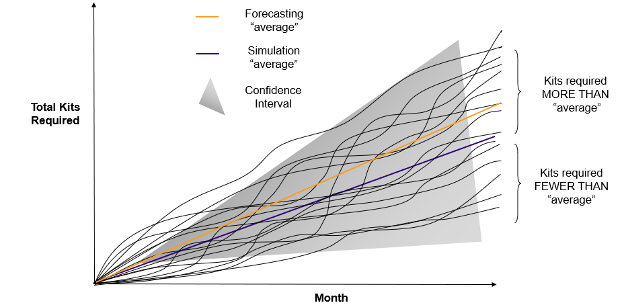Calyx’s Supply Simulation is a clinical trial supply forecasting service that improves trial efficiencies by helping sponsors estimate study supply requirements based on sophisticated simulation modeling methodology.
By testing a design aspect/assumption, as well as various potential recruitment patterns, Calyx’s in-house expert statistical design and trial supply consultants run a simulation to help sponsors make informed decisions about the quantity of medication to produce for use in clinical development.
Some of the most common use cases for the service include, but are not limited to:
- Evaluating the amount of medication required to start and maintain clinical trial enrolment
- Predicting how long an existing amount of study medication will last
- Determining the optimal site and depot buffer stock quantities required to ensure dispensation while reducing the cost and burden of excessive drug wastage
Calyx’s Supply Simulation service enables trial sponsors to run their clinical trial design as a simulation before patients are screened, medication has been ordered, and packaging designs/protocols have been finalized.
But how does it work? We break it down for you here.

“Simulations investigate several “what if” scenarios – since some parameters are unknown up-front – which is not possible with static forecasting.“
– Malcolm Morrissey, Calyx
Head of Statistics & Product Support Services
Modeling Methodology Summarized
Simulations allow for the comparison of multiple scenarios tailored to the study, from varying supply chain issues to variable patient titration.
Simulation or Forecast?
A forecast is defined as a static prediction or estimate of a future event or trend. A forecasting tool takes data as a point of entry and creates a likely state of the data in the future.
A simulation considers variable factors that could impact the data used as an entry point. In clinical supplies, a simulation considers the likelihood of some events occurring, and how they affect medication consumption.
With Calyx Supply Simulation, averages are obtained on parameters such as overage, number of shipments, and the risk of not being able to supply patients – these estimates are more accurate than forecasting estimates since we consider more factors and real-world variability.
Simulations provide us with ranges (or confidence intervals) that give us a sense of what we can expect to happen in the study with certain degrees of confidence. Therefore, Calyx Supply Simulation can be used to define what the optimal supply strategy should be e.g., how much buffer stock should be held at sites and depots.
Simulations also allow us to investigate several “what if” scenarios – since some parameters will be unknown up-front i.e., educated guesses – which is not possible with static forecasting.
Total Kits Required over Time

Chart 1: By running multiple simulations, an average of the total required kits is obtained, which is more precise than a simple forecasting average
Simulation Run
We refer to a simulation run as a single representation of what might happen in the study, resulting in the estimation of the total kits required over time for study execution.
By running multiple simulations (multiple runs), we can obtain an average for the total kits required, which is more precise than a simple forecasting average (See Chart 1).
Let’s suppose that we decided to base the number of kits required for the study on the simulation average, then:
- If the actual study behaved similarly to any of the lower simulation runs, we would be producing more kits than would be required
- If the actual study behaved similarly to any of the higher simulation runs, we would have insufficient kits produced
It is therefore vital that we not only consider the average but also the information provided across the many simulation runs. This cannot be achieved via a static forecasting approach.
Monte Carlo Simulation Technique
Some of the key elements of a clinical trial are variable, such as subject recruitment. It is important that the modeling approach incorporates variability into the study simulation so a full range of outcomes can be studied. Monte Carlo simulation allows such an approach, sampling values for key variables from underlying specified distributions of some of the input parameters.
Monte Carlo Simulation Applied to Patient Recruitment
While the average study recruitment for a group of sites may be e.g., two patients per site per month, there is a chance that an individual site may recruit zero patients or as many as six or seven patients in any month.
Monte Carlo simulations account for this variability by using a random number generator to determine each site’s recruitment for each month of the simulation. The random number generator is weighted to return numbers in the proportions that underlie the theoretical distribution. This process is like rolling a die to mimic real-world variability.
Benefits of a Service
The Calyx Statistics and Product Support Services team (SPSS) provides advice and consultancy on randomization and medication management as a standard for all the studies supported by Calyx IRT. Why not utilize that experience to help set up and refine your simulation to meet the requirements for your specific trial?
For example, from their experience of setting lookahead windows, trigger and resupply levels, and other IRT supply chain settings, the SPSS team can minimize kit wastage in a simulation to the point where the chances of a failed visit are at an acceptable level. The acceptable level is discussed with the sponsor and is study-specific. The further amount of medication needed to remove all failed visits can also be shown to ensure an appropriate level of overage is chosen.
Conclusion
Don’t fret over the difficult task of estimating how much drug to manufacture and package for your trial, and when. Leverage the expertise of Calyx’s in-house expert statistical design and trial supplies consultants to help you optimize protocol design to balance the cost of shipments and reduce waste, and assess the impact of protocol amendments, by comparing ‘what if’ scenarios via the Calyx Supply Simulation service.

















